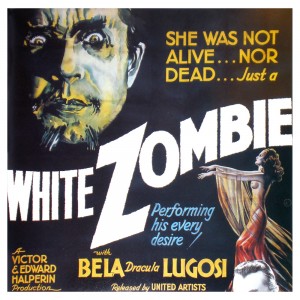Looking at Kee’s “From Cannibal to Zombie and Back Again”, there is a heavy significance placed on the word “Other” which refers to the colonial slang the white body has appropriated onto the black body (Kee, 2011). Other is a term that puts this group of people at a distance from the white body, placing a negative label on the black body and demonstrating the noticeable difference between races. The white body showcased its abhorrent power during the slave trade and Victor Hugo Halperin reimagined this time through the first zombie referenced horror film White Zombie (1934). This film is set in Haiti and references the zombie voodoo folklore that fascinated 1930’s America because “it cast an entire group of people as beings without humanity” and who could work tirelessly for the rest of white America (Kee, 2011). This dehumanization of the Other allows for the viewer to separate the black from the white body but when the female white body is zombified, she also represents the Other even though she is representative of the white body. This new layer of zombification/otherness shows the thinly veiled misogyny in the film and showcases the fear of miscegenation that was rampant at that time that women carried the same primitive aspect of the Other and would therefore form interracial relationships.
Focusing on the film’s portrayal of woman, the stereotypical woman recoiling in fear in the presence of a zombie is seen on the movie’s poster. In this, woman are established as the powerless subject in the film and have more in common with the Other than a white man. Bela Lugosi is the star of the film and plays the slave master; from the poster he is portrayed as a god-like floating head whose eyes are transfixed on the nude female body. With taglines like “She was not dead…nor alive, yet she walked, breathed, and performed his every wish”, the misogynistic tone is not hidden at all and portrays the female as a “simultaneous corpse, slave and sex-object” (Daileader, 2005). Daileader (2005) also writes about Lugosi’s rampant misogyny in real life which reminds me of one of my favourite Bauhaus songs “Bela Lugosi’s dead”, I’m not sure if the band’s intent was to celebrate the end of his life but in this context it ironically fits with the desire to overthrow of the zombie master and end the segregation of the Other.
Daileader, C.R. (2005). Racism, misogyny and the othello myth. New York, NY: Cambridge University Press
Kee, Chera. (2011). “They are not men they are dead bodies!”: From Cannibal to Zombie and back again”. In D. Christie, and S.J. Lauro (Ed.), Better of Dead The Evolution of the Zombie as Post-Human. (pp. 9-24). New York, NY: Fordham University Press

